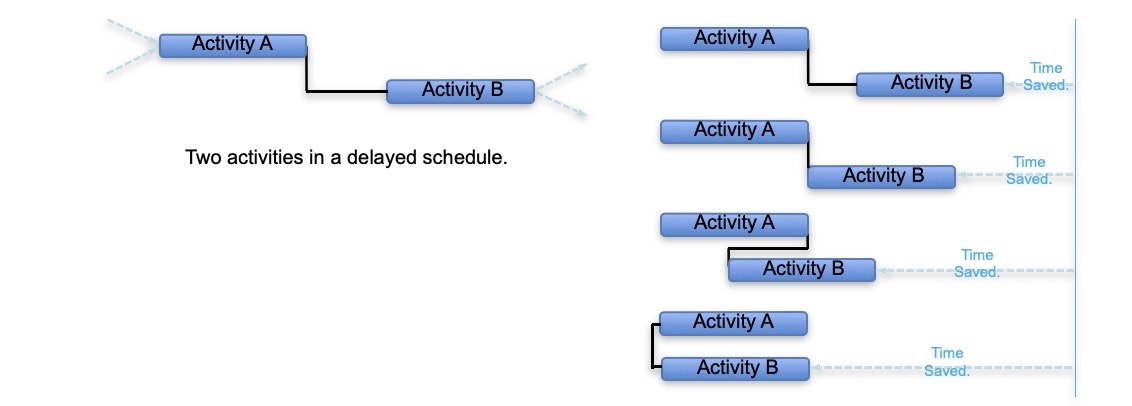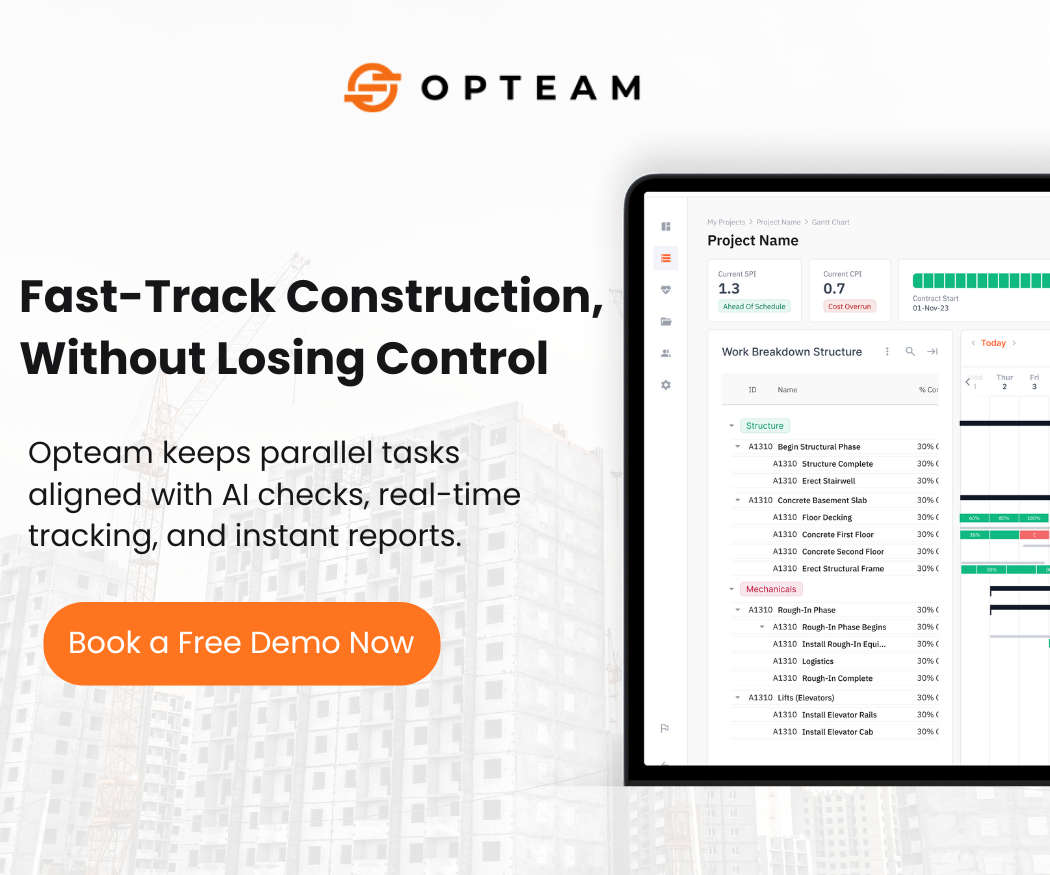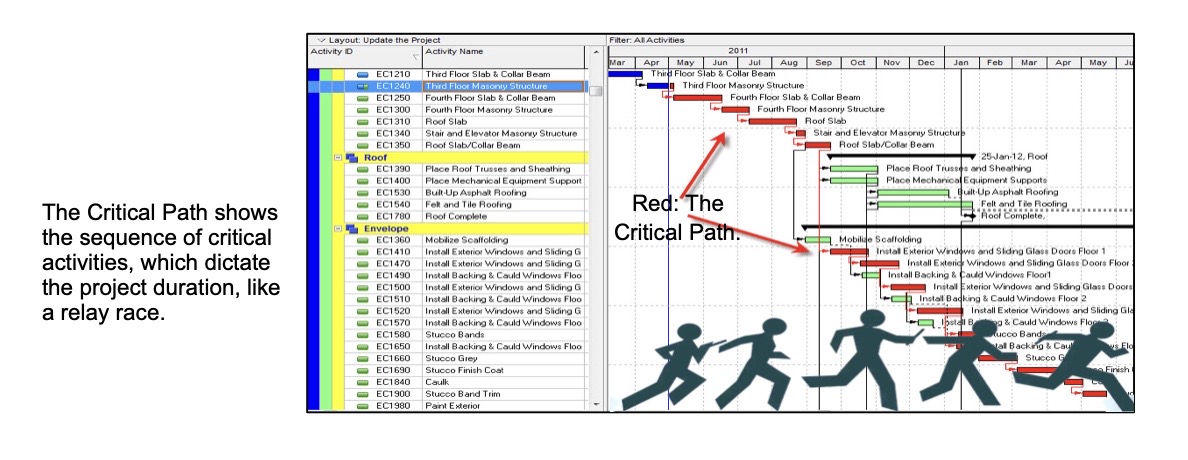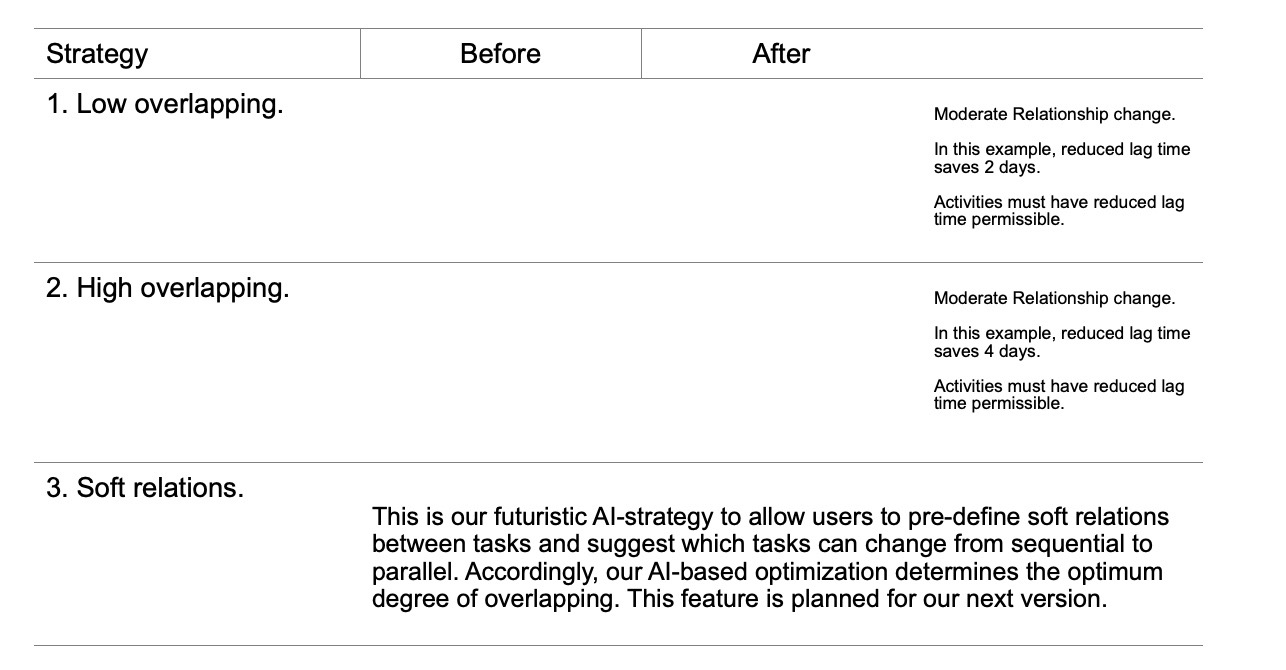Thinking about using fast-tracking method in your construction project?
There are a million reasons for every construction project to be delayed, resulting in large penalties and a bad reputation. Construction Statistics reveal that for every month of project delay, there is an average cost overrun of 7.7%. This indeed ruins the profitability of a project. Therefore, good planners must have in their toolbox some cost-effective strategies to recover from delays and speed up construction.
The least-costly strategy to speed up construction and recover from delays is “Fast-Tracking”, which introduces changes to the schedule by having some activities run more in parallel (different degrees shown below), rather than one-after-the-other, thus reducing the overall timeline. Which activities to choose and what degree of fast-tracking to apply are two important decisions for the planner.

What is Fast-Tracking in Construction?
Fast-tracking in construction is a project scheduling technique where activities that would normally be done sequentially are performed in parallel to save time.
Instead of waiting for one phase to be fully complete before starting the next, parts of the design, procurement, or construction stages overlap. For example, a contractor might begin foundation work while design for the upper floors is still being finalized.
This approach is commonly used when project deadlines are tight, such as in large infrastructure projects or commercial developments with strict opening dates.

Fast-Tracking Advantages
In construction, going fast is not just nice to have—it’s crucial. Compared to other ways to speed up construction such as adding more resources and working overtime hours, Fast-Tracking has several advantages. These are:
1- Less cost: focuses on changing the relationships among critical activities, which carries little or no cost to implement. And when the project duration is shorter, the project per-day indirect costs (e.g., rentals, transportation, etc.) are reduced.
2- Market Advantage: with rapid project development, the project can hit the market superfast, thus bringing value to customers sooner. It also means faster profits, which changes the game economically.
3- More Agile Execution: being able to change and learn as you go, being adaptable to changes, and solving problems practically as they come. This translates into good collaboration among all project teams, a good reputation, and more business to come.
Fast Tracking Disadvantages
- Higher risk of errors and rework – Since activities overlap, design changes or unforeseen issues in earlier phases can impact work already completed, leading to costly rework.
- Coordination challenges – Multiple teams working simultaneously increase the chance of miscommunication, scope conflicts, and scheduling clashes.
- Cost overruns – While fast-tracking is intended to save time, mistakes, rework, and inefficiencies can drive up project costs.
- Quality concerns – Rushed processes or skipped checks can compromise construction quality and safety if not properly managed.
- Increased management pressure – Project managers and stakeholders must closely monitor progress, requiring stronger oversight and more robust project controls.
- Contractual and liability issues – Overlapping responsibilities between design, procurement, and construction may create disputes about accountability if problems arise.
What is Delaying My Project, and What to Fast-Track?
Typically, once you enter the project activities, their durations, and their relationships into any scheduling software, the software performs CPM analysis to show the “Critical Path” of the project, which is the longest sequence of activities, from beginning to end, like a relay race, as shown in next figure.
This is the longest path (sequence) of “Critical” activities, that follow each other with Finish-to-Start (FS) relations. The length of this path represents the value of the project duration, which is hopefully within the project prescribed deadline. All these critical activities have zero “Total Float” values, i.e., no allowance for delays, i.e., a delay of one day to any of these activities, delays the project.
As such, because the critical path dictates project duration, its critical activities are the ones that are responsible for delaying the project. Thus, these critical activities, and their relationships, are the ones that need to be focused upon in a delay-recovery strategy such as Fast-Tracking.

Software Challenges and Fast-Tracking Risks
Fast-Tracking targets to adjust the relationships among critical activities to recover delays. This can be done by selecting two activities on the critical path and changing the sequential relationship between them in different ways, as shown earlier.
However, the process is tricky to implement on existing scheduling software because it is basically a manual process left to the experience of the planner who needs to look ahead, identify potential risks, and make proper decisions. Here are the common challenges.
1- Manual choices: In the jungle of project activities, the critical path can contain tens or hundreds of activities. The software provides no guidance on which activities to choose and which level of Fast-Tracking to apply.
2- Critical Path Changes: When you apply Fast-Tracking to some activities, it is possible that some non-critical activities can become critical or multiple critical paths can be formed. This can be slippery road for more problems later.
3- Potential for Rework: When you change the relationship between two activities to get them more in parallel than in sequence, you are basically speeding the tasks a more than originally intended and working the crews of the two activities in the same space, creating some congestion. These issues may result in some lower quality issues. In this case, it is wise to watch for the need for some rework at the end of the task to fix any quality issues, as shown below.
Such an allowance for rework means a provision for a longer activity duration than originally planned.

The Fast-Tracking Process
There’s no room for mistakes with fast timelines. Due to the above challenges, managing tight schedules, making quick decisions, and ensuring everything stays in sync can be daunting tasks.
Here are the ways to change the relationship between two critical activities.

Fast-Tracking Example in Construction
An example of fast-tracking in construction is when a contractor begins site preparation and foundation work while the architectural and structural designs for the upper floors are still being finalized. Instead of waiting for the full design package to be complete, the project team uses partial drawings (such as early foundation and structural plans) to start construction earlier.
This allows the project timeline to move forward while design work continues in parallel.
A real-world scenario might be the construction of a high-rise office building with a strict handover deadline. The developer wants the project completed within 24 months instead of the typical 30 months. To achieve this, excavation and concrete works begin as soon as preliminary drawings are approved, while mechanical, electrical, and finishing designs are still under development.
This overlapping of design and construction phases helps shorten the project duration but also requires tight coordination to avoid costly rework if later design revisions affect already completed work.
Opteam turns static charts into dynamic, living and breathing schedules
Construction has long since needed a solution to help managers recover their projects. Opteam empowers construction managers to automatically utilize fast-tracking strategies to devise realistic alternatives for project completion. With Opteam, managers are equipped to adapt quickly and efficiently, ensuring project success even amidst unforeseen challenges.
There are good reasons why Opteam has one of the fastest growing tractions in construction companies:
- Pathway Suggestions: Generate different strategies for project completion, considering current progress, constraints and potential roadblocks.
- Automating Intelligent Fast-Tracking: Identify which tasks are best suited for acceleration and adjust strategies accordingly to maximize efficiency.
- Objective Prioritization: Dynamically adjust resources to focus on critical milestones, meeting tight deadlines, or optimizing budget use.
Forward-thinking construction companies adopting Opteam are reducing their project delays by 30%. Explore Opteam’s solutions today and join the movement of digitization in construction.
Conclusion
Fast-Tracking is growing popular in modern construction. This method can speed up projects and cut costs. It can also help you start earning from your project sooner. But it does call for strong project management and knowing the risks of speeding things up. To get the most from fast-track construction, plan your strategy well. Work with skilled trades who know how to move quickly. Don’t let project management complexities hold you back. Join the revolution with Opteam and experience the future of construction planning and scheduling today! Contact us now or try it here by uploading your Primavera file.



